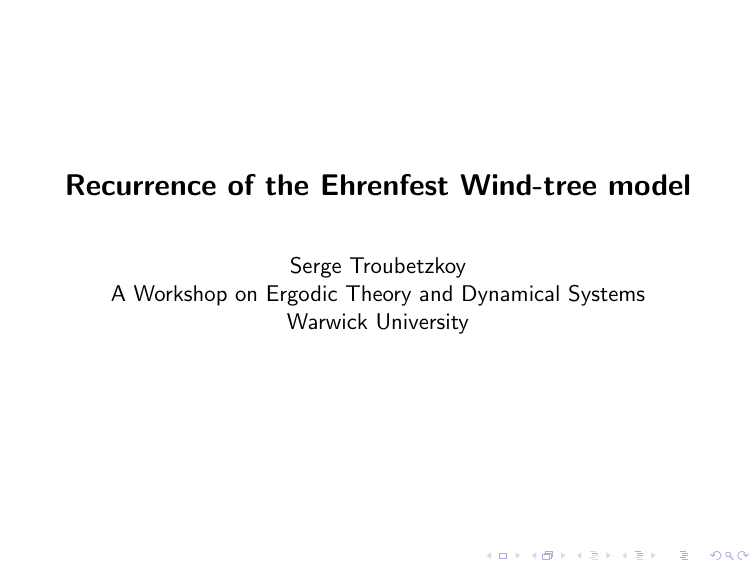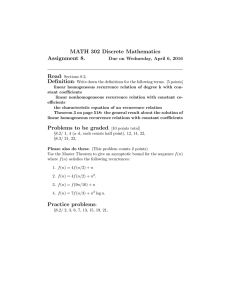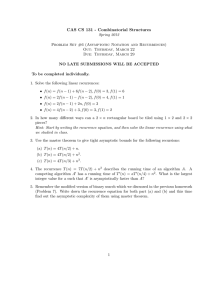Recurrence of the Ehrenfest Wind-tree model Serge Troubetzkoy Warwick University
advertisement

Recurrence of the Ehrenfest Wind-tree model
Serge Troubetzkoy
A Workshop on Ergodic Theory and Dynamical Systems
Warwick University
In 1912 Paul and Tatiana Ehrenfest proposed the wind-tree model
of diffusion in order to study the statistical interpretation of the
second law of thermodynamics and the applicability of the
Boltzmann equation.
In 1912 Paul and Tatiana Ehrenfest proposed the wind-tree model
of diffusion in order to study the statistical interpretation of the
second law of thermodynamics and the applicability of the
Boltzmann equation.
In the Ehrenfest wind-tree model, a point particle (the “wind”)
moves freely on the plane and collides with the usual law of
geometric optics (angle of incidence = angle of reflection) with
randomly placed parallel rectangular scatterers (the “trees”).
The only illustration in the Ehrenfests’ article.
Note that if one fixes the direction of motion θ, then the motion
takes only 4 directions {±θ, ±θ + π}
Note that if one fixes the direction of motion θ, then the motion
takes only 4 directions {±θ, ±θ + π}
Originally the Ehrenfest’s proposed studying a single direction
θ = π/4.
Note that if one fixes the direction of motion θ, then the motion
takes only 4 directions {±θ, ±θ + π}
Originally the Ehrenfest’s proposed studying a single direction
θ = π/4.
It is natural to study this model for all directions.
Note that if one fixes the direction of motion θ, then the motion
takes only 4 directions {±θ, ±θ + π}
Originally the Ehrenfest’s proposed studying a single direction
θ = π/4.
It is natural to study this model for all directions.
The phase volume is an infinite invariant measure.
Note that if one fixes the direction of motion θ, then the motion
takes only 4 directions {±θ, ±θ + π}
Originally the Ehrenfest’s proposed studying a single direction
θ = π/4.
It is natural to study this model for all directions.
The phase volume is an infinite invariant measure.
One would like to know if it is almost surely recurrent for a certain
direction, for almost every direction.
Full occupancy lattice case
Consider the Z2 lattice with a fixed a by b rectangle centered at
each lattice point (i, j) ∈ Z2 .
In 1980 Hardy and Weber proved that for special choices of a and
b and for certain special choices of directions the billiard flow is
recurrent.
In 1980 Hardy and Weber proved that for special choices of a and
b and for certain special choices of directions the billiard flow is
recurrent.
They used rectangle obstacles with a =
|α| < 1) and θ = π/4.
1−α
4
and b =
1+α
4
(with
In 1980 Hardy and Weber proved that for special choices of a and
b and for certain special choices of directions the billiard flow is
recurrent.
They used rectangle obstacles with a =
|α| < 1) and θ = π/4.
1−α
4
and b =
1+α
4
(with
For these special choices of parameters the application T 4 , the
fourth return to the boundary of rectangles, is a skew product over
a rotation by angle α, i.e.
T 4 (s, (i, j)) = (s + α, (i, j) + φ(s)) where s is arc length on the
boundary of the rectangle.
In 1980 Hardy and Weber proved that for special choices of a and
b and for certain special choices of directions the billiard flow is
recurrent.
They used rectangle obstacles with a =
|α| < 1) and θ = π/4.
1−α
4
and b =
1+α
4
(with
For these special choices of parameters the application T 4 , the
fourth return to the boundary of rectangles, is a skew product over
a rotation by angle α, i.e.
T 4 (s, (i, j)) = (s + α, (i, j) + φ(s)) where s is arc length on the
boundary of the rectangle.
The recurrence then can be proven easily from the Denjoy Koksma
lemma (now standard technique).
In 1980 Hardy and Weber proved that for special choices of a and
b and for certain special choices of directions the billiard flow is
recurrent.
They used rectangle obstacles with a =
|α| < 1) and θ = π/4.
1−α
4
and b =
1+α
4
(with
For these special choices of parameters the application T 4 , the
fourth return to the boundary of rectangles, is a skew product over
a rotation by angle α, i.e.
T 4 (s, (i, j)) = (s + α, (i, j) + φ(s)) where s is arc length on the
boundary of the rectangle.
The recurrence then can be proven easily from the Denjoy Koksma
lemma (now standard technique).
They also estimated the diffusion rate, the particle escapes at a
speed of at most log t log log t
For each (a, b) with a/b irrational this method works for a finite
collection of directions θ.
For these special directions one can identify the ergodic
decomposition (Conze and Gutkin 2010). For example, in the
direction
π/4 JEAN-PIERRE
with a/b irrational,
there are 2 ergodic components.
4
CONZE AND EUGENE GUTKIN
In the first component the generic orbit hits all obstacles with
This is a special case of the general situation, as we explain in Thecenter
(i, j) with i + j = 0 mod 2, while in the second i + j = 1
orem 5 and Theorem 6.
mod 2.
Almost all direction results on the full occupancy case
Hubert, Lelièvre, T.
Define a dense subset of parameter values:
E = (a, b) = (p/q, r /s) ∈ Q × Q :
(p, q) = (r , s) = 1, 0 < p < q,
p, r odd, q, s even .
0 < r < s,
Almost all direction results on the full occupancy case
Hubert, Lelièvre, T.
Define a dense subset of parameter values:
E = (a, b) = (p/q, r /s) ∈ Q × Q :
(p, q) = (r , s) = 1, 0 < p < q,
p, r odd, q, s even .
0 < r < s,
Theorem (HLT)
If the rectangular obstacles have dimension (a, b) ∈ E, then, for
the billiard table Ta,b :
I
there is a subset P of Q, dense in R, such that every regular
trajectory starting with direction in P is periodic;
I
for almost every direction, the billiard flow is recurrent with
respect to the natural phase volume.
Let
E0 =
(a, b) = (p/q, r /s) ∈ Q × Q :
(p, q) = (r , s) = 1, 0 < p < q,
p, r even, q, s odd ,
For j ∈ N let logj = log ◦ · · · ◦ log (j times).
0 < r < s,
Let
E0 =
(a, b) = (p/q, r /s) ∈ Q × Q :
(p, q) = (r , s) = 1, 0 < p < q,
p, r even, q, s odd ,
0 < r < s,
For j ∈ N let logj = log ◦ · · · ◦ log (j times).
Theorem (HLT)
If the rectangular obstacles have dimension (a, b) ∈ E 0 , then, for
the billiard table Ta,b :
I
there is no direction α ∈ Q such that all regular trajectories
starting with direction α are periodic;
I
there is a subset P of Q, dense in R, such that no trajectory
starting with direction in P is periodic;
dist(φθ x, x)
∀ k ≥ 1, for a.e. θ, lim sup Qk t
= ∞ almost surely.
t→∞
log
t
j
j=1
I
Generic full occupancy results
As a corollary, we obtain a result for a dense Gδ of parameters in
(0, 1)2 .
Corollary (HLT)
Consider any closed Y ⊂ (0, 1)2 for which E ∩ Y and E 0 ∩ Y are
dense in Y. Then there is a residual set G ⊂ Y such that, for each
(a, b) ∈ G ,
I
the billiard flow on Ta,b is recurrent;
I
the set of periodic points is dense in the phase space of Ta,b ;
I
dist(φθ x, x)
= ∞ almost surely.
∀ k ≥ 1, for a.e. θ, lim sup Qk t
t→∞
j=1 logj t
Generic full occupancy results
As a corollary, we obtain a result for a dense Gδ of parameters in
(0, 1)2 .
Corollary (HLT)
Consider any closed Y ⊂ (0, 1)2 for which E ∩ Y and E 0 ∩ Y are
dense in Y. Then there is a residual set G ⊂ Y such that, for each
(a, b) ∈ G ,
I
the billiard flow on Ta,b is recurrent;
I
the set of periodic points is dense in the phase space of Ta,b ;
I
dist(φθ x, x)
= ∞ almost surely.
∀ k ≥ 1, for a.e. θ, lim sup Qk t
t→∞
j=1 logj t
Recently Avila and Hubert have improved the recurrence part of
this result to all (a, b).
Theorem
(Delecroix) If a and
√ b are rational or quadratic of the
√ form
1/(1 − a) = x + y D and 1/(1 − b) = (1 − x) + y D with x,y
rationals and D > 1 a square free integer, then there exists a set
Λ ⊂ S1 of Hausdorff dimension at least 1/2 such that for every
θ ∈ Λ and all x with infinite forward orbit in the direction θ,
lim inf t→∞ d(x, φθt (x)) = ∞, i.e the flow φθt is divergent.
Theorem
(Delecroix) If a and
√ b are rational or quadratic of the
√ form
1/(1 − a) = x + y D and 1/(1 − b) = (1 − x) + y D with x,y
rationals and D > 1 a square free integer, then there exists a set
Λ ⊂ S1 of Hausdorff dimension at least 1/2 such that for every
θ ∈ Λ and all x with infinite forward orbit in the direction θ,
lim inf t→∞ d(x, φθt (x)) = ∞, i.e the flow φθt is divergent.
Theorem
(Delecroix,Hubert, Lelievre) For almost every (a, b) including the
(a, b) described above
lim sup
t→∞
log d(x, φθt x)
2
= .
log t
3
for almost all θ and all x with infinite forward orbit.
Non-periodic models
Fix a finite or countable set of dimensions of obstacles
F ⊂ (0, 1)2 ∪ {(0, 0)} such that F ∩ (E ∪ G ) 6= ∅. Consider the set
2
2
configurations F Z with the product topology on F Z . A lattice
site with an obstacle of dimension (0, 0) will be interpreted as a
lattice site without obstacle.
Non-periodic models
Fix a finite or countable set of dimensions of obstacles
F ⊂ (0, 1)2 ∪ {(0, 0)} such that F ∩ (E ∪ G ) 6= ∅. Consider the set
2
2
configurations F Z with the product topology on F Z . A lattice
site with an obstacle of dimension (0, 0) will be interpreted as a
lattice site without obstacle.
Lemma (T)
For each ergodic shift invariant measure on the configuration space
2
F Z , the wind-tree models are almost surely recurrent or almost
surely non recurrent.
Lemma (T)
For each ergodic shift invariant measure on the configuration space
2
F Z , the wind-tree models are almost surely recurrent or almost
surely non recurrent.
Theorem (T)
There is a dense Gδ subset G of configurations such that the
billiard flow is recurrent for every billiard table in G with respect to
the natural phase volume.
The proof also proves recurrence for a dense Gδ of Lorentz gases
(without finite horizon).
The proof also proves recurrence for a dense Gδ of Lorentz gases
(without finite horizon).
Erodicity (joint work with M. Lenci)
In the one dimensional case one can prove recurrence and
ergodicity for almost every Lorentz tube (without finite horizon).
Ergodicity can also be shown for a dense set of aperiodic Lorentz
gases (without finite horizon).
The ideas of the proof of Theorem 1.
Theorem 1 (HLT) If the rectangular obstacles have dimension
(a, b) ∈ E, then, for the billiard table Ta,b :
I
there is a subset P of Q, dense in R, such that every regular
trajectory starting with direction in P is periodic;
I
for almost every direction, the billiard flow is recurrent with
respect to the natural phase volume.
1) The dynamics can be understood by considering a compact
genus 2 translation surface whose periodic orbit structure can be
well understood.
1
a
1
b
b
1
a
1
Consider a direction θ which connects a center of a vertical side of
an obstacle to a center of a horizontal side (or vice versa). A study
of the symmetries imply that all orbits are periodic on the compact
surface and on the infinite surface.
Obstacle size (1/2,1/2), slope 1.
Obstacle size (1/2,1/2), slope 1.
Slope 3/7
Slope 7/9
Slope 7/9
Slope 9/11
Slope 9/29
Escaping trajectories: slopes 3/4, 10/17, 14/17, 16/37, for
obstacle size 1/2 × 1/2. The grayed obstacles are hit at the same
location, so the trajectory repeats afterwards with a drift.
2) Using the action of the Veech group (group of affine
diffeomorphisms of the surface) one proves that these directions
are dense.
3) Finally using diophantine approximation we can prove that a.e.
direction is recurrent.
∂R
J
J
B
slope pn /qn
slope θ
Recurrence: trajectories starting in J with direction θ follow the
cylinder with direction pn /qn unless they are in the small
subinterval B. Thus those point in J not in B recur to J.
Ideas of the proof of Theorem 7.
Theorem 7 (T) The is a dense Gδ subset G of configurations such
that the billiard flow is recurrent for every billiard table in G with
respect to the natural phase volume.
The idea of the proof is simple. A table in G will have infinitely
many large annuli for which the table has a fixeed obstacle at all
lattice sites in the annuli. The widths of these annuli will increase
sufficiently quickly to guarantee the recurrence.
P. Hubert, S. Lelièvre and S. Troubetzkoy The Ehrenfest wind-tree
model: periodic directions, recurrence, diffusion Journal fuer die
reine und angewandte Mathematik (Crelle’s Journal)
S. Troubetzkoy Typical recurrence for the Ehrenfest wind-tree
model Journal of Statistical Physics 141 (2010) 60-67.
V. Delecroix DIvergent trajectories in the periodic wind-tree model
V. Delecroix, P. Hubert, and S. Lelièvre Diffusion for the wind-tree
model
J.P. Conze and E. Gutkin On recurrence and ergodicity for
geodesic flows on noncompact periodic polygonal surfaces
M. Lenci and S. Troubetzkoy Infinite-horizon Lorentz tubes and
gases: recurrence and ergodic properties Physica D (2011).




